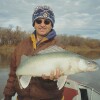GRAND FORKS – Extended flooding last spring kept anglers off the Red River longer than usual, but once they finally got out, fishing was pretty good, based on results from the North Dakota Game and Fish Department’s 2022 creel survey.
Anglers logged an estimated 63,057 hours of fishing pressure on the U.S. portion of the river during the summer of 2022, Game and Fish statistics show, down from 88,860 hours during the last survey in 2015 and 121,269 hours during the 2010 survey. Game and Fish funded the 2022 creel survey, which was scheduled for 2020 but postponed two years because of the COVID-19 pandemic.

Minnesota and North Dakota share management of the Red River and alternate funding for the survey, which is conducted in five-year intervals. The Minnesota Department of Natural Resources funded the 2015 survey, and Game and Fish funded the 2010 survey.
According to Todd Caspers, Northeast District fisheries biologist for Game and Fish in Devils Lake, the creel survey was scheduled to begin in May, but flooding last spring delayed the start of the survey along downstream portions of the river. As part of the survey, Game and Fish hired two creel clerks, based in Fargo and Grand Forks, to interview anglers and collect fishing information along five “clusters,” or stretches of the river, from Wahpeton-Breckenridge to the Manitoba border.
The Grand Forks-based clerk didn’t start working until mid-June, Caspers said. Even then, downstream areas near Drayton weren’t fishable until July, he said.
ADVERTISEMENT
“Overall effort was down a fair bit, but the caveat with that was really bad conditions those first couple of months,” Caspers said. “Flooding and everything last spring put a crimp in the anglers’ style, I guess you could say.
“Every site was a little different.”
As in 2015, the survey included a sampling site at Orwell Dam on the Otter Tail River in Minnesota.
By the numbers
Despite the slow start, fishing pressure actually increased in July, August and September when compared with the 2015 survey, Caspers said.
Boat traffic in August was down “a little bit” from 2015, for whatever reason, but August still was the busiest month on the Red River, overall, with an estimated 23,583 hours of fishing pressure, Caspers said, up from 22,363 hours in August 2015.
“It’s kind of going out on a limb, but if it hadn’t been a flood year, we might have seen a little bit of an increase in fishing effort for the summer,” he said. “But it’s hard to say for sure.”
Fishing-wise, anglers caught an estimated 44,764 channel catfish on the Red River and kept 4,368 cats during the survey period, Caspers said. That’s fairly similar to 2015, when anglers caught an estimated 44,721 catfish and kept 6,868 catfish.
ADVERTISEMENT
Some other survey highlights:
- Anglers on the Red River landed an estimated 3,585 walleyes and kept 1,820 fish. That’s up from a harvest of 769 walleyes in 2015.
- Anglers caught an estimated 889 saugers and kept 231 on the Red. That’s down from a harvest of 895 saugers in 2015.
- Anglers caught an estimated 5,455 smallmouths, of which 305 were kept. That’s up from a total catch of 899 smallmouths and a harvest of 153 fish in 2015.
- Anglers logged 10,288 hours of fishing pressure at the Orwell Dam on the Otter Tail River, Caspers said, up slightly from 9,525 hours in 2015. “The Otter Tail wasn’t as impacted by the flood,” he said.
- Anglers caught an estimated 119 sturgeon on the Red River, up from 27 in 2015, and 93 sturgeon at Orwell Dam on the Otter Tail River, up from 69 in 2015.
- Anglers also caught an estimated 5,582 walleyes and 3,531 catfish at Orwell Dam, harvesting 1,646 walleyes and 838 catfish. That compares with a harvest of 1,305 walleyes and 1,225 channel catfish at Orwell Dam in 2015.
New survey method
In addition to in-person interviews, the 2022 survey for the first time gave anglers the option of filling out a creel survey electronically. The two creel clerks distributed postcards to shore anglers and left cards on the windshields of vehicle-boat trailer rigs parked at survey access sites. Anglers could then either scan a QR code or go to the website listed on the card to access the online creel survey.

The postcard option accounted for 63% of the data collected from boat-based anglers, Caspers said, with an overall response rate of 33.5%. By comparison, the response rate among shore anglers to the postcard survey was only 15.2%.
“Overall, the online creel card survey did provide useful data for a very minor cost, but a higher shore angler response would have been nice,” Caspers said.
In total, 570 interviews representing 1,051 people were collected on the Red River between in-person and postcard surveys, Caspers said. The Otter Tail River survey yielded 73 interviews representing 99 people.
The Minnesota DNR will fund and conduct the next creel survey on the Red River, which is scheduled for 2027.










